Portuguese vs Spanish - Similarities, Differences & Knowing Both for Travel | 2024 (with Examples)
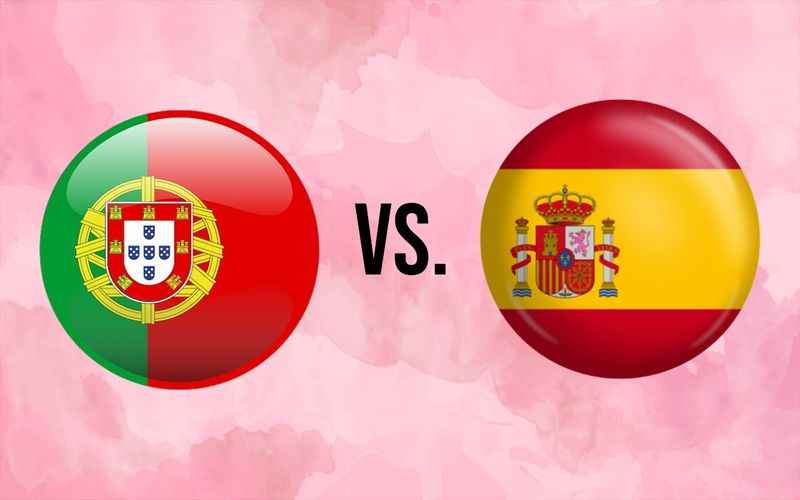
Both Spanish and Portuguese derive from the Latin language family. Both languages are spoken in Europe and Latin America, but how similar are they and what are their key differences?
In this article, we will uncover the differences between Portuguese and Spanish and then delve into their similarities. We will address the benefits of learning each of these languages from a travel standpoint and explain where they are both spoken.
By the end of this guide to Spanish and Portuguese, you should feel inspired to learn one or both of these Romance languages.
So, let's dive into this ultimate guide to Portuguese and Spanish.
Portuguese vs Spanish: Where They’re Spoken

Spanish is one of the world's most popular languages, spoken by more than 580 million people worldwide.
That's 7.8% of the world's population. It is the most common language in South and Central America. Within this region, Spanish is the official language of 20 countries, including Argentina, Chile, Bolivia, Peru, Colombia, and Venezuela.
Each of these countries has its own local, regional, and national accents and dialects. So, whichever accent you end up adopting, you'll come across plenty more during your learning journey.
Portuguese, on the other hand, is spoken in 10 countries worldwide. These include Brazil, Mozambique, Angola, Portugal, and Guinea-Bissau, equating to 280 million people. This makes Portuguese the ninth most spoken language in the world.
Whilst Spanish is the most widely spoken Romance language in the world, Portuguese is a close second (in terms of native speakers).
The Difference Between Portuguese and Spanish
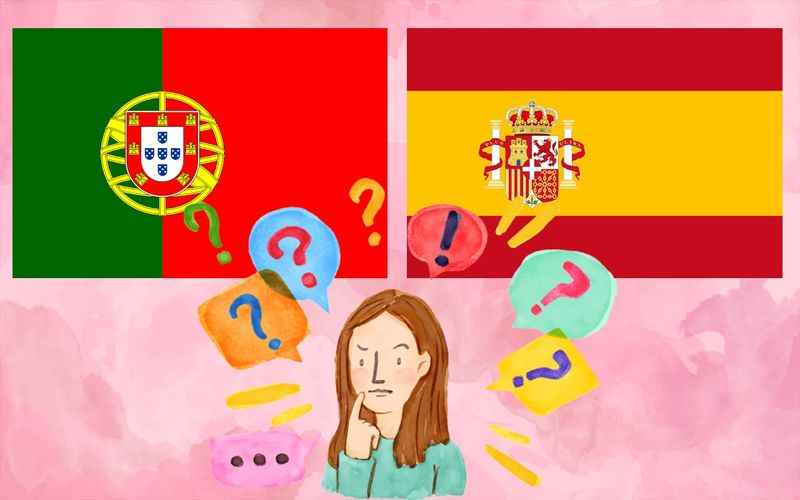
Although Portuguese and Spanish are similar languages and both originate from the Iberian Peninsula, they are distinct languages with their own unique characteristics.
While they share many similarities, including a high degree of lexical overlap, they should not be considered mutually intelligible.
In fact, despite having a lexical similarity of around 90% of cognate vocabulary, understanding one language does not guarantee comprehension of the other, particularly in spoken forms.
Most obvious differences between Portuguese and Spanish lie in their pronunciation. Portuguese pronunciation is generally considered more complex than Spanish, with its unique vowel sounds, nasalization, and distinct phonetic patterns.
These intricacies can pose challenges for Spanish speakers trying to understand spoken Portuguese, as the pronunciation nuances may differ significantly.
On the other hand, Portuguese speakers tend to have an easier time understanding Spanish speakers. Due to the shared lexical similarities and some similarities in grammar and syntax, Portuguese speakers can often decipher the meaning of written or spoken Spanish with relative ease.
However, it's important to note that despite the commonalities, Portuguese and Spanish are separate languages with distinct linguistic features. Each language has its own vocabulary, idiomatic expressions, regional accents, and cultural nuances that contribute to its uniqueness.
While knowledge of one language can certainly facilitate the learning of the other, it is essential to approach them as individual entities to fully appreciate their differences.
The Similarity of the Languages: Portuguese vs Spanish
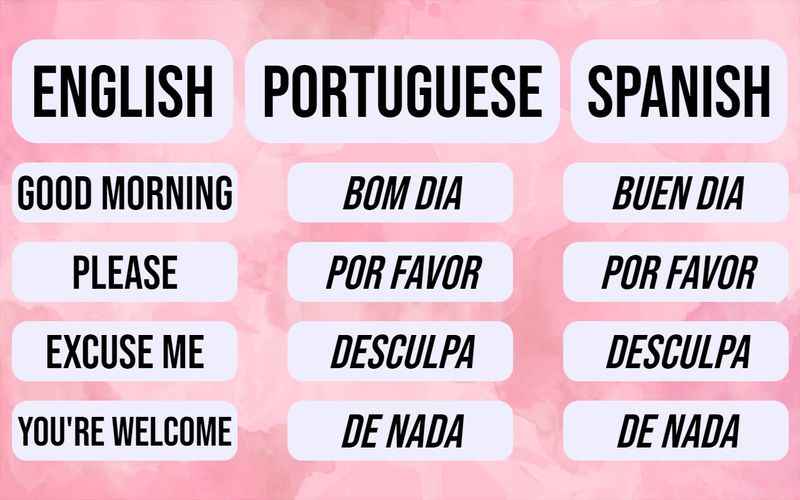
When exploring the similarities between Portuguese and Spanish languages, it becomes evident that these two languages share a strong bond due to their historical connection.
Both Portuguese and Spanish are part of the larger group of Romance languages, which evolved from Vulgar Latin, one of the spoken forms of Latin during the Roman Empire. As members of the Romance language family, they have common roots and exhibit resemblances in their vocabulary, grammar, and structure.
Spanish and Portuguese are classified as Ibero-Romance languages, which refer to the languages spoken on the Iberian Peninsula. Alongside Spanish and Portuguese, other Ibero-Romance languages include Catalan, Galician, and Basque. These languages have developed separately yet influenced one another throughout history.
When examining the written forms of Portuguese and Spanish, you'll notice many similarities in their vocabulary. Numerous Portuguese and Spanish words share a common origin, particularly those derived from Vulgar Latin.
In fact, both languages have borrowed extensively from Vulgar Latin, making their lexical similarity quite high.
Furthermore, these two languages feature similar verb conjugations, particularly in the infinitive form. Many verbs exhibit parallel forms, making it easier for learners of one language to comprehend the other.
Nouns also display resemblances, enabling speakers of either language to recognize and understand a significant portion of vocabulary.
In terms of pronunciation, there are subtle differences between Portuguese and Spanish. Portuguese has a more complex phonetic system compared to Spanish. It includes a nasal vowel sound and distinct vowel pronunciation.
However, despite these vowel sound variations, speakers of Portuguese and Spanish can still communicate effectively in written form, given the high lexical similarity.
As part of the Romance language family, Portuguese and Spanish share similarities with all the Romance languages such as French, Italian, and Romanian. These languages, known for their rich history and cultural influence, exhibit common features in terms of vocabulary, grammar, and syntax.
Therefore, learning either Portuguese or Spanish can provide a foundation for exploring other Romance languages.
It's important to note that while Portuguese and Spanish are closely related, they are different languages with their own unique characteristics. Each language has its own pronunciation nuances, regional variations, and cultural expressions.
Although there are similarities, it's essential to approach them as separate entities to fully appreciate their individuality.
Spanish Vs Portuguese Examples:
Look at the sentences below and you'll see that Spanish and Portuguese are extremely similar in many ways.
Not only are many of the verbs the same in the infinitive form (with a similar conjugated form) but nouns are also alike.
Here is the first example:
English: “Is there a place to eat Brazilian food close to here?”
Spanish: “¿Hay algún lugar para comer comida brasileña cerca de aquí?”
Portuguese:“Tem algum lugar para comer comida brasileira perto daqui?”
The second example shows the same:
English: “Where do you recommend I buy my shopping in this neighborhood?”
Spanish: “¿Dónde me recomiendas que compre mis compras en este barrio?”
Portuguese: “Onde você recomenda que eu compre minhas compras neste bairro?”
You can see the same thing for the following sentence as well:
English “I have booked a table at this restaurant. Do you want to eat there?”
Spanish: “He reservado una mesa en este restaurante. ¿Quieres comer ahí?”
Portuguese: “Eu reservei uma mesa neste restaurante. Você quer comer aí?”
The fourth example shows the same:
English: “Do you want to go for a drink with me tonight?”
Spanish: “¿Quieres ir a tomar una copa conmigo esta noche?”
Portuguese: “Você quer ir tomar uma bebida comigo esta noite?”
These similar-looking sentences have the same meaning as well:
English: “Where can I find more information?”
Spanish: “¿Dónde puedo encontrar más información?”
Portuguese: “Onde posso encontrar mais informações?”
As you'll see from these five sentences, it's no surprise that speakers of Portuguese and Spanish are able to read the other language in its written form.
Portuguese vs Spanish: How Are They Similar?
We've seen from the sentences above that Portuguese and Spanish are very similar. Now, we understand why this is.
Let's explore the specific ways in which these languages differ.
1. The Characters
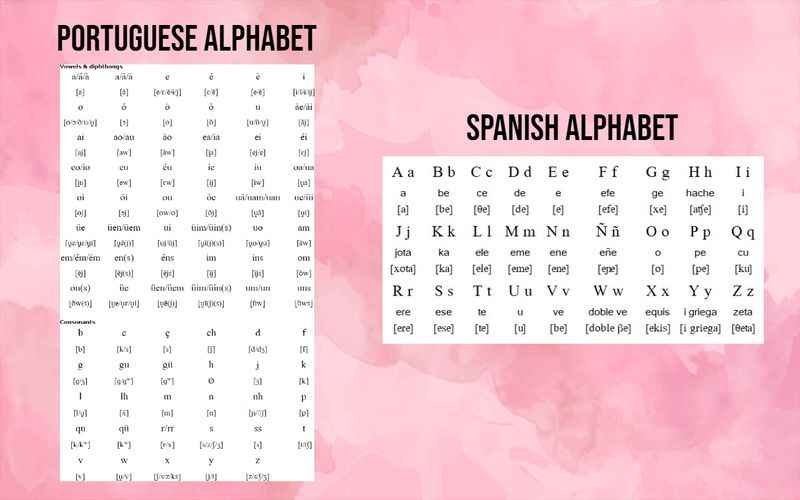
Spanish is a phonetic language with 27 letters in its alphabet. Portuguese, on the other hand, is not phonetic and contains the same 26 letters as English.
Many words, including numbers, will remain relatively similar when they are translated from Portuguese to Spanish. Often, the difference is as little as one vowel, as you'll see below.
The reason for the additional vowel is often diphthongs, which are sounds that are created when two vowels are combined. Spanish diphthongs include: ue, ua, ie, ia.
These are substituted for an ei or an ai in Portuguese.
The Portuguese diphthong ei replaces the letter e in Spanish. Below are some examples of how diphthongs are used to differentiate between the Spanish and Portuguese languages:
Wood in Spanish is madera, while in Portuguese it’s madeira.
New in Spanish is nuevo, while in Portuguese it’s novo.
First in Spanish is primero, while in Portuguese it’s primeiro.
As you can see, one Portuguese and Spanish word can contain diphthongs which is the only thing to differentiate them.
These differences will be seen more in writing than in the spoken language, although diphthongs do alter the pronunciation of some words.
2. The Tones
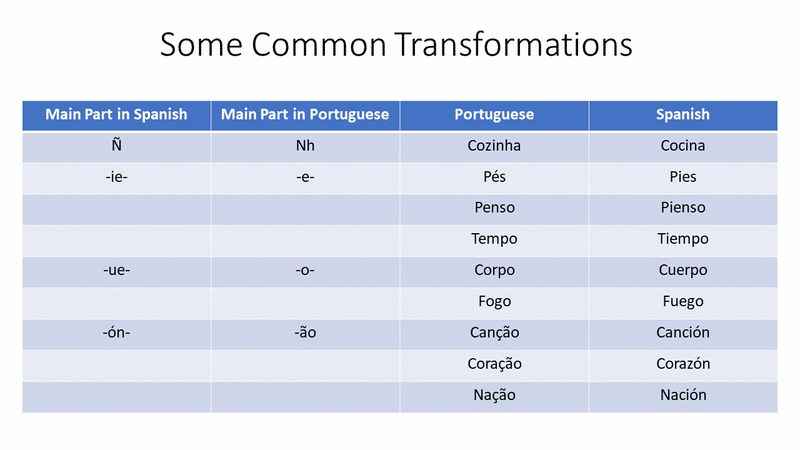
Understanding tones is important when learning to speak Spanish or Portuguese with any degree of fluency. Whilst neither language is considered a tonal language like Mandarin or Korean, the intonation of accents in both languages varies depending on the country.
The Spanish in Argentina, for example, differs greatly in tone and intonation from that of its Castilian Spanish counterpart in Spain. The same is true for Portuguese in Brazil, which is far more varied in tone and intonation than the Portuguese spoken in its native Portugal.
Neither language relies on the pitch of words to convey meaning. However, the accents placed on words in both languages indicate where the stress of the word should be when spoken aloud.
3. Expressions and Idioms

Like most languages, Spanish and Portuguese are full of fixed expressions and idiomatic phrases.
Learning the expressions and idioms of any language is beneficial. It is one of the quickest ways to sound like you possess a high level of fluency, even if you are still learning.
Below are a few of the most common idioms of Spanish.
Tomar el pelo - translates to ‘to take the hair’, which can be compared to the English saying to pull someone’s leg.
Tirar la casa por la ventana (Spanish) - means ‘to throw the house through the window’. While this might seem peculiar at first, it is simply the Spanish way of saying to spare no expense, or that money is no object.
Lo dijo de labios para fuera (Spanish) - translates to ‘he said it from the lips outwards'. In other words, you’d say this when you didn’t mean something you said prior.
Likewise, Portuguese speakers have their own idioms in their native tongue. Let’s take a look at a few of these.
Uma andorinha não faz verão (Portuguese) - translates to ‘one swallow does not make a summer', which is a much nicer way of saying that working together is better than working alone.
Comprar gato por lebre (Portuguese) - 'to buy a cat thinking it was a rabbit'. This is an idiom that translates to being fooled in English.
Está para nascer um burro (Portuguese) - translates to 'a donkey is about to be born’, which refers to being shocked when someone is doing something out of the ordinary. If it’s hard to believe, you can use this idiom.
Portuguese vs Spanish: The Spoken Languages
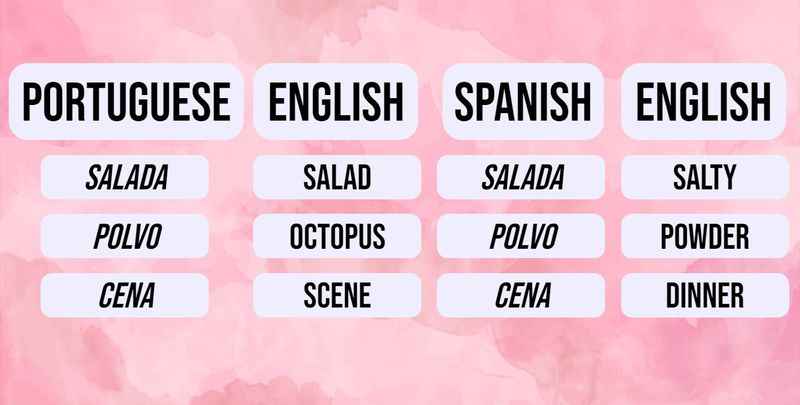
The majority of words in the Spanish and Portuguese languages are similar to one another, which makes them easier to understand if you know one language fluently. As mentioned earlier, 90% of the words in both languages have a cognate (a similar-looking equivalent).
However, there are some false cognates within these languages which means that some words can look very similar but mean completely different things. For example:
- Salty in Spanish is salada, while in Portuguese salada __means salad.
- Powder in Spanish is polvo, while in Portuguese polvo __means octopus.
Although these examples are funny, they are easy mistakes to make. Falling for a false cognate could become rude and offensive very quickly!
Likewise, there are some words in the Spanish language that are completely different in the Portuguese language. An example of this would be dinner, which is cena __in Spanish, and jantar __in Portuguese.
- Cena in Portuguese means scene, which is completely different from dinner.
Benefits of Learning Portuguese

- You'll be able to communicate with more than 200 million people.
- You'll familiarize yourself with new cultures on multiple continents.
- Your resume will improve, with Portuguese often required by employers.
These are just some of the benefits you'd achieve if you start learning Portuguese.
If you are a speaker of Spanish already, it makes perfect sense to choose Portuguese as your next language. According to the British Council, only 5% of the Brazilian population is able to communicate in English.
Being able tospeak Portuguese is incredibly useful. It will enable you to converse with natives in Portugal and Brazil, whether on vacation or traveling for work.
Both Portugal and Brazil are home to fascinating cultures which can only be explored properly if you are able to understand the language.
Portugal has incorporated Arabic language influence, evident in the inclusion of around 800 vocabulary words of Arabic origin. This cultural exchange has left a lasting impact on the Portuguese language, adding a distinct flavor to its lexicon.
The Arabic influence is a testament to the historical and linguistic connections between Portugal and Arab cultures.
A good way to practice Brazilian Portuguese, in particular, is through music. Brazil is home to a range of original dance styles. These include forró, repente, coco de roda, axé, sertanejo, samba, bossa nova.
Best Courses to Learn Portuguese
There are many ways to learn Portuguese, either online or through spending time in Portuguese or Brazil. We recommend one course in particular which is also suitable for Spanish learners.
Pimsleur

Pimsleur's courses are known for their emphasis on oral proficiency and practical conversational skills. By focusing on listening and speaking exercises, Pimsleur helps learners develop their language skills in a natural and immersive way.
Pimsleur’s aim is to get users fully conversational in a foreign language as quickly as possible. Its course structure is based on its own successfully proven method. Pimsleur offers all users a free 7-day trial in a variety of popular languages.
Check out our review of Pimsleur.
Rosetta Stone

Rosetta Stone offers an immersive language learning experience that focuses on developing speaking, listening, and comprehension skills. Their interactive program utilizes speech recognition technology to help learners improve their pronunciation. With a variety of lessons and activities, Rosetta Stone provides a comprehensive approach to learning Portuguese.
Their course also emphasizes modern Portuguese grammar, ensuring learners develop a solid foundation in the language. Whether you're a beginner or already have some knowledge of Spanish, Rosetta Stone can help you confidently speak Portuguese as a native language.
Babbel

Babbel is another popular language learning platform that offers a range of Portuguese courses designed for different proficiency levels.
Their interactive lessons cover various aspects of the language, including vocabulary, grammar, and conversation skills.
With a focus on real-life scenarios and practical dialogue, Babbel helps learners develop the confidence to speak Portuguese in everyday situations.
Their courses are created by native Portuguese speakers, ensuring an authentic language experience.
Whether you're a Spanish speaker looking to expand your language skills or starting from scratch, Babbel provides an effective and engaging way to learn Portuguese.
Benefits of Learning Spanish

- You'll be able to communicate with more than 580 million people.
- You'll familiarize yourself with new cultures.
- Spanish is the third most required language by employers.
Spanish is now considered the most important language to learn in the U.K. and U.S. Being able to speak Spanish provides a plethora of social and professional opportunities.
Mexico, for example, is now one of the fastest-growing economies in the world. Only 12% of Mexicans are able to communicate in English. Knowledge of Spanish is, therefore, pretty essential for any company wishing to work in this market.
As the most commonly spoken Romance language in the world, the ability to speak Spanish will also enable you to learn other languages.
We've seen in this post how similar Portuguese is to Spanish, but both languages also resemble French, Italian, and Romanian. Knowledge of Spanish will make learning any of these languages much easier.
Best Courses to Learn Spanish
We've created a list of the best ways to learn Spanish online. The list below takes into account the various types of language learners. Whether you're looking for a Spanish course to complete on your own, a Spanish tutor, or an app, you will find it below.
Fluent Spanish Academy
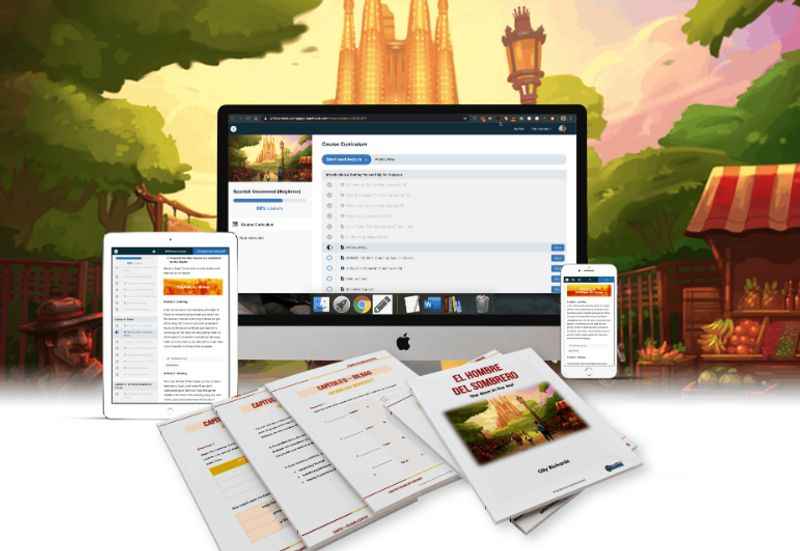
Spanish Uncovered is part of the Fluent Spanish Academy series. It comes from a creator that speaks eight languages. The method is simple - quick and direct immersion. The course jumps right in with a story.
The idea is that working with long pieces of text is as challenging as it is rewarding, so you’ll never feel like the course is too easy.
You’ll work on different PDF documents, which teach you the language as well as the grammar. This course will work best for avid readers who enjoy a challenge!
Baselang

Baselang offers a fast way to become a fluent Spanish speaker. For $149 p/month, you get unlimited online Spanish classes with native tutors. Baselang provides a well-structured curriculum to help you learn, and you can schedule as many classes as you like, whenever you like.
If you take a class a day, the cost works out at less than $5 p/hour. Click here to receive a $10 discount on your first paid month. Baselang offers all users 7 days of unlimited Spanish lessons for $1. You can find out more here.
Rocket Spanish
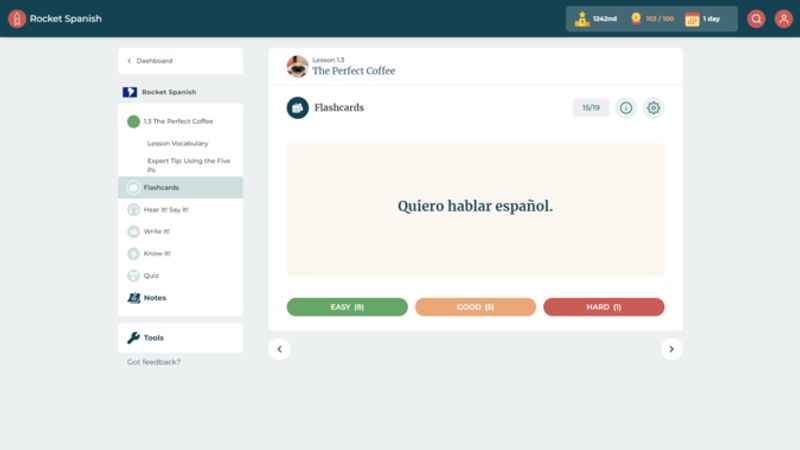
Rocket Spanish is a language learning app that uses audio lessons, interactive exercises, and readings to get you to a conversational level in Spanish.
Through its structured and proven successful process, you will begin to understand more about the language you are learning.
Check out our review of Rocket Languages.
Traveling with Portuguese vs Spanish
When traveling with Portuguese and Spanish, you'll notice that these two languages share many similarities, but there are also distinct differences to be aware of.
One key factor to consider is that European Portuguese differs from Brazilian Portuguese, and European Spanish differs from Latin American Spanish. While the basics remain the same, the pronunciation, vocabulary, and even grammar differ slightly.
Similarly, when traveling across Europe, you'll encounter various Spanish and Portuguese-speaking regions, each with its own unique accent and cultural nuances.
In Spanish-speaking countries, where the main language is Spanish, knowing Portuguese can still be beneficial as there are many cognate words and shared vocabulary between the two languages.
Overall, embracing Portuguese as a very fluid language opens up a world of new connections and experiences during your travels.
Traveling across Europe

Exploring Europe is an exciting opportunity to witness the diverse cultures and languages of the continent. As you venture through different countries, you'll encounter various dialects and accents of Portuguese and Spanish.
European Portuguese differs from Brazilian Portuguese in terms of pronunciation and vocabulary, but it remains mutually intelligible. It's worth noting that while Spanish is widely spoken in many European countries, particularly in Spain itself, knowing Portuguese can still be advantageous.
It allows you to communicate effectively with a Portuguese speaker among locals and expand your cultural interactions. Embrace the beauty of these romantic languages and enjoy the richness they bring to your European travel experiences.
Traveling in Spain

When traveling in Spain, Spanish is the main language spoken throughout the country. You may come across some Portuguese speakers, and you can even try using your Portuguese to get by in Spain.
The shared roots between Portuguese and Spanish make it easier to understand and communicate with locals, despite some variations in accent and vocabulary.
That being said, it is much easier and more advantageous to speak Spanish in Spain. This will make the locals more likely to be helpful, and you might even get better prices on food, drink, and market stall items if you speak to vendors in Spanish.
Whether you are using Spanish or Portuguese in Spain, you should immerse yourself in the vibrant culture, savor the delicious cuisine, and engage in conversations that bridge the gap between these two Ibero-Romance languages.
Traveling in Portugal
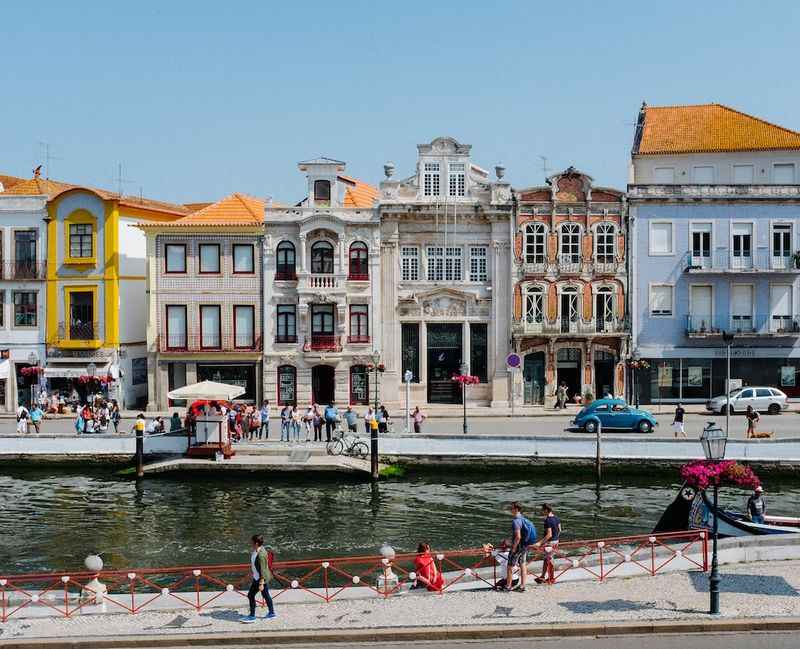
Traveling in Portugal offers a unique opportunity to fully immerse yourself in the Portuguese. As the birthplace of the language, Portugal provides an ideal environment to refine your Portuguese accent and skills.
You'll encounter the local accent and colloquial expressions that may differ from what you've learned in another Portuguese-speaking country. Interacting with native speakers allows you to deepen your understanding of Portuguese grammar, vocabulary, and cultural nuances.
Embrace the warmth and hospitality of the Portuguese people as you navigate the charming streets, indulge in traditional cuisine, and explore the captivating history and landmarks of this beautiful country.
As with traveling in Spain, you will find the locals more accommodating if you speak Portuguese, but you can always try out your Spanish if all else fails.
Traveling in other countries

While Portugal and Spain are the main Portuguese- and Spanish-speaking countries, these two languages extend beyond their borders. Many other countries around the world have significant Portuguese and Spanish-speaking communities.
For instance, Andorra, parts of Africa, and most of South America also speak Spanish, while Angola, parts of Africa, and Brazil also speak Portuguese.
Traveling to these destinations provides a unique opportunity to further develop your language skills and connect with local cultures.
Whether it's exploring the vibrant streets of Brazil, immersing yourself in the rich heritage of Cape Verde, or delving into the colorful traditions of Mozambique, your knowledge of Portuguese will open doors to unforgettable experiences.
Meanwhile, taking your Spanish to the Caribbean can be an eye-opening experience.
Embrace the adventure of discovering new languages, customs, and landscapes as you travel beyond the traditional Portuguese and Spanish-speaking territories.
Traveling Across South America

Traveling across South America offers an incredible opportunity to immerse yourself in the rich cultural and linguistic diversity of the continent.
Portuguese and Spanish are the predominant languages spoken in these countries, with Portuguese being the official language in Brazil and Spanish widely spoken in countries like Argentina, Peru, and beyond.
Embrace the chance to explore the mesmerizing landscapes, indulge in delicious cuisine, and engage with locals to experience the unique flavors of Portuguese and Spanish across South America.
Traveling in Brazil

When traveling in Brazil, it's essential to familiarize yourself with Brazilian Portuguese, the official language of the country.
While Spanish may be understood by some locals in tourist areas, communicating in Portuguese will greatly enhance your experience.
Learning a few key phrases and expressions, such as greetings, ordering food, and asking for directions, will go a long way in connecting with the warm and friendly Brazilian people.
Additionally, understanding the Portuguese equivalent of certain words or phrases commonly used in Spanish can help bridge the communication gap and make your travels in Brazil more enjoyable and immersive.
Traveling in Peru

As you embark on your journey through Peru, knowing some basic Spanish will greatly enrich your experience.
Spanish is the official language of Peru, and communicating with locals in their native tongue opens doors to deeper cultural interactions.
From exploring ancient Inca ruins to navigating bustling markets, speaking Spanish allows you to connect with Peruvians on a more personal level.
Familiarizing yourself with common Spanish words, mastering essential phrases, and building your Spanish vocabulary will empower you to fully appreciate the rich history, stunning landscapes, and warm hospitality that Peru has to offer.
Traveling in Argentina

In Argentina, the official language is Spanish, and this dialect of Latin American Spanish is known for its distinct accent.
While the basic structure and vocabulary are similar to standard Spanish, there are notable differences in pronunciation, grammar, and vocabulary usage.
Immersing yourself in the local language will enhance your experience as you explore the vibrant streets of Buenos Aires, indulge in delicious asado (barbecue), and immerse yourself in the passionate tango culture.
Embrace the unique linguistic nuances of Argentine Spanish, including the distinctive pronunciation of "ll" and "y" sounds, lunfardo slang, and the melodic intonation of porteños (residents of Buenos Aires), to fully embrace the Argentine way of life.
Traveling in other countries

Beyond Brazil, Peru, and Argentina, South America offers a tapestry of other languages and cultures to discover.
In countries such as Chile, Colombia, Ecuador, and Bolivia, Spanish is the dominant language, with each country adding its own regional accents and vocabulary.
Exploring these countries allows you to expand your Spanish language skills while immersing yourself in diverse landscapes and vibrant cultures.
Additionally, countries like Suriname, French Guiana, and Guyana introduce different languages such as Dutch, English, and Creole, reflecting their unique colonial histories.
Embracing the linguistic diversity of the South American continent enriches your travel experience and fosters connections with people from various backgrounds, creating unforgettable memories along the way.
Traveling Around Central America
Central America is a region brimming with diverse cultures and languages.
Spanish is predominantly spoken throughout the region, as well as French, English, and Mayan languages, however, Portuguese is not.
That being said, being able to speak Portuguese can still be advantageous, as it opens up opportunities to connect with Portuguese speakers visiting the area, and it can help you to read menus or signs.
Embrace the adventure of exploring Central America and consider expanding your language skills beyond Spanish and Portuguese to fully immerse yourself in the local culture and communicate with a wider range of people.
Traveling to Mexico

Mexico, a vibrant and diverse country, is predominantly a Spanish-speaking nation. While Portuguese is not widely spoken, having a foundation in Spanish will undoubtedly enhance your travel experience.
Speaking Spanish allows you to connect with the friendly locals, delve into Mexico's rich history and traditions, and navigate through its enchanting cities and archaeological sites with ease.
Whether you're exploring the ancient ruins of Chichen Itza, indulging in authentic Mexican cuisine, or enjoying the beautiful beaches, speaking Spanish will enable you to fully immerse yourself in the fascinating culture and vibrant atmosphere of Mexico.
Traveling to Puerto Rico

As a territory of the United States, English and Spanish are both official languages in Puerto Rico.
While Portuguese is not commonly spoken, having proficiency in Spanish will greatly benefit your travels to this beautiful Caribbean island.
From strolling through the colorful streets of Old San Juan to relaxing on pristine beaches, being able to communicate in Spanish allows you to connect with locals, savor the local cuisine, and navigate the island with ease.
Embrace the opportunity to learn a new language and enhance your travel experiences in Puerto Rico by expanding your Spanish language skills.
Traveling to Other Countries

Beyond Mexico and Puerto Rico, Central America offers a myriad of countries to explore, each with its own unique culture and language dynamics.
While Portuguese may not be widely spoken in these countries, embarking on the journey to learn a new language opens doors to deeper cultural interactions and meaningful connections.
Whether you're venturing to Honduras, Nicaragua, Guatemala, or any other country in the region, being able to speak Spanish will enrich your travel experiences, allowing you to engage with locals, navigate local markets, and fully embrace the vibrant atmosphere of Central America.
Embrace the opportunity to learn a new language and embark on unforgettable adventures throughout this enchanting region.
Common Language-Related Misconceptions: Portuguese vs Spanish

When it comes to comparing Portuguese and Spanish, there are several common language-related misconceptions that can lead to confusion.
One of the most prevalent misconceptions is that Portuguese is simply a dialect of Spanish or that they are interchangeable. In reality, Portuguese and Spanish are distinct languages with their own unique characteristics and grammar.
Another is that Portuguese and Spanish are mutually intelligible, which they are not. While speakers of one language tend to understand speakers of the other well enough, these languages are not the same, as we have seen.
By debunking these misconceptions, language learners can approach Portuguese and Spanish with a clearer understanding of their differences and similarities.
While they share common roots and vocabulary, they have evolved into distinct languages with their own unique characteristics.
Embracing these differences and recognizing the shared aspects can enhance your language learning journey and deepen your appreciation for the richness of both Portuguese and Spanish languages.
Learning Spanish as a Portuguese Speaker and Vice Versa
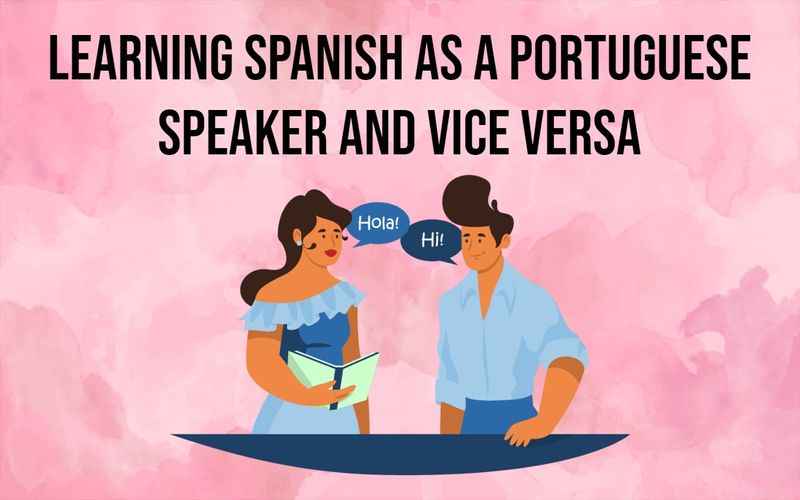
Learning Spanish as a Portuguese speaker, or vice versa, can be a rewarding and relatively straightforward process due to the many similarities between the two languages.
As both Spanish and Portuguese belong to the Ibero-Romance branch of the Romance language family, they share a significant amount of vocabulary and grammatical structures.
Portuguese speakers often find it easier to understand spoken Spanish due to the similarities in pronunciation and grammar.
One advantage of being a Portuguese speaker learning Spanish is the vast number of cognates, which are words that have similar forms and meanings in both languages. This allows for quicker acquisition of vocabulary and comprehension of written texts.
Additionally, the grammatical structures, such as verb conjugation and sentence formation, follow similar patterns in both languages.
However, it's important to note that despite the similarities, there are still differences between Portuguese and Spanish that learners need to be aware of. These differences primarily lie in pronunciation, vocabulary nuances, and some grammatical rules.
Portuguese has a more complex sound system with nasal vowels and unique phonetic features, while Spanish has its own distinct pronunciation patterns.
To learn Spanish successfully as a Portuguese speaker, it is beneficial to focus on the specific areas that may pose challenges, such as different verb conjugations, vocabulary variations, and pronunciation adjustments.
Language learning resources tailored for Portuguese speakers can be helpful in addressing these specific needs and guiding learners through the process.
Similarly, for Spanish speakers learning Portuguese, the similarities in vocabulary and grammar can facilitate the learning journey. However, attention should be given to the differences in pronunciation, verb conjugation, and some grammatical structures unique to Portuguese.
Ultimately, with dedication, practice, and exposure to the target language through various learning resources, immersion experiences, and conversational opportunities, Portuguese speakers can become proficient in Spanish, and Spanish speakers can become proficient in Portuguese.
The similarities between the two languages allow for a smoother transition and open doors to deeper cultural understanding and communication opportunities across the Portuguese and Spanish-speaking world. Just look out for false friends while you begin this learning journey!
False Friends
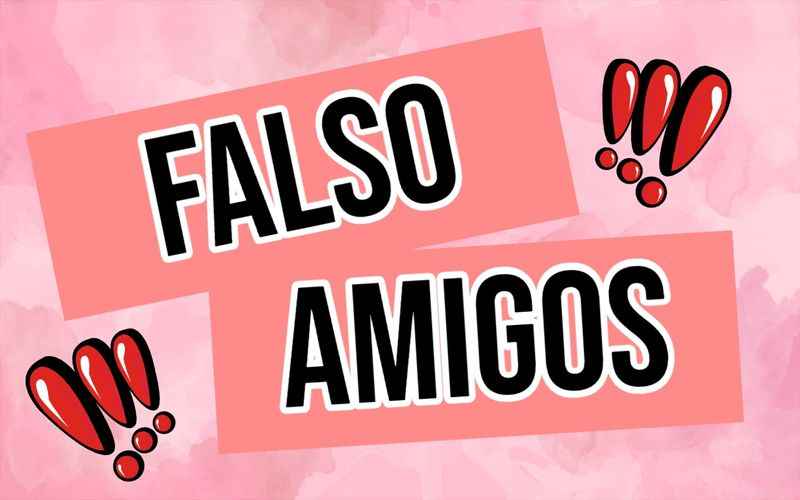
A false friend is a linguistic trap that can catch language learners off guard. These are words that are spelled the same or similarly in two languages but have completely different meanings.
Many examples can be found in Portuguese and Spanish, two languages that share many similarities due to their common Latin origins.
A common false friend is the word "roxo." In Portuguese, "roxo" means "purple." However, in Spanish, "rojo" means "red." While the words look similar, their meanings diverge significantly.
These false friends can cause confusion if one were to use "roxo" to describe something red in Spanish-speaking contexts.
Navigating false friends requires a keen awareness of the differences in meanings between Portuguese and Spanish words. It's essential to rely on context and actively learn the correct usage of words to avoid misunderstandings.
Understanding false friends can also provide language learners with insights into the interconnectedness of written languages and the complexities of their evolution.
While false friends can pose challenges, they also offer opportunities for deeper language exploration. By recognizing false friends, learners can develop a greater appreciation for the nuances and intricacies of the Portuguese and Spanish languages.
Embrace these linguistic curiosities as you embark on your language-learning journey, and remember to be mindful of the differences and similarities between Portuguese and Spanish words.
FAQs Related to Portuguese vs Spanish
Let's take a look at some frequently asked questions about Portuguese vs Spanish
Can a Spanish person understand a Portuguese person?
While Spanish and Portuguese are closely related, the languages are not totally mutually intelligible.
Spanish speakers may be able to understand written Portuguese to some extent but understanding spoken Portuguese can be more challenging due to differences in pronunciation and vocabulary.
Are Spanish and Portuguese similar?
Spanish and Portuguese are similar in many aspects due to their common Vulgar Latin origin. They share vocabulary and grammatical structures, making it easier for speakers of one language to learn the other.
However, they also have distinct differences in pronunciation, vocabulary, and idiomatic expressions.
Can you speak Spanish if you know Portuguese?
Knowing Portuguese can provide a solid foundation for learning Spanish. The two languages share many similarities, including vocabulary and grammar.
While there will still be differences to learn, such as pronunciation and specific vocabulary, knowledge of Portuguese can certainly facilitate the learning of Spanish.
Is it easier to learn Spanish or Portuguese?
The perceived difficulty of learning Spanish or Portuguese can vary depending on individual factors and language background. Generally, Spanish speakers find it easier to learn another Romance language due to the shared linguistic features.
However, the difficulty ultimately depends on personal learning preferences and dedication to language study.
Summing Up: Portuguese vs Spanish
Let's sum up Portuguese vs Spanish with a few concise points. Due to their origins, Spanish and Portuguese are incredibly similar, sharing a lexical similarity of 90%. As a result of this, speakers of one language are able to comprehend the other, particularly in written form.
Speakers of Portuguese are much more likely to understand spoken Spanish than vice-versa. This is due, mostly, to the fact that Spanish pronunciation is less complex than Portuguese. Spanish is a phonetic language, whilst Portuguese is not.
Spanish is the more widely spoken language than the other, but there is no denying that these two languages are beautiful. Learning either will enhance your social and professional life, improving your resume in the process.
In conclusion, embracing the similarities and differences between Portuguese and Spanish can open doors to rich cultural experiences, improved communication, and expanded opportunities.
So, don't hesitate to embark on this linguistic adventure and discover the fascinating world of Portuguese and Spanish languages.







